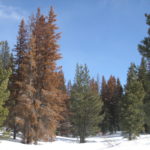Removing small trees leaves water for bigger ones and for dwindling reservoirs
Posted: January 12, 2017Source: The Economist

“Like too many straws in a drink,” trees suck up groundwater before it can seep into streams that feed reservoirs, says David Edelson of The Nature Conservancy. The project director for the Sierra Nevada range, source of 60% of California’s consumed water, notes that as a warmer climate lengthens the growing season, trees’ thirst will only increase. This has led to a push for large numbers of trees to be cut or burned down. Overgrown forests catch more snow and rain on leaves and needles, where wind and sunlight increase the amount of moisture lost to evaporation.
To reduce what Tim Murphy, a Forest Service ecologist, considers an excessive number of trees in forests, the service thinned 600 square miles of California’s watershed in the year to October, up from 367 the previous year. By burning or removing about 40% of tree and plant-life in these areas, the Forest Service wants to do more than put extra water in reservoirs. The goal is also to reduce the severity of wildfires and to get water into the bigger trees left standing—more than five years of drought have killed more than 66m trees in California, aerial surveys show.
Thinning efforts are off to a great start but must accelerate, says Timothy Quinn, head of the Association of California Water Agencies. Five times as much forest should be thinned every year, estimates Roger Bales, a hydrologist at the University of California, Merced. To find out how much extra water a thinned watershed produces, the university has placed sensors in thinned and control plots in the Stanislaus-Tuolumne Experimental Forest north of Yosemite National Park. Depending on landscape and precipitation, thinned areas shed 10-40% more water into streams, Mr Bales estimates.
More accurate numbers will be available next year. The hope, says Eric Knapp, a Forest Service ecologist in Redding, is that a new thinning technique will prove to produce even more water when flow volumes from next spring’s snowmelt are known. Some plots are not thinned evenly, but rather by clear-cutting gaps with a diameter one or two times the height of surrounding trees. The idea is to clear an area big enough for a good snowpack to form, but small enough for shade to reduce evaporation and extend the melting season.
California’s governor recently signed a bill that facilitates thinning watersheds. But some environmentalists resist “cutting any tree for any reason”, as the Forest Service’s Mr Murphy puts it. And some think thinning doesn’t produce meaningfully more run-off. That’s the opinion of Chris Frissell of Frissell & Raven Hydrobiological and Landscape Sciences, a consultancy in Polson, Montana. Thinning has become popular in the state, but, he says, it disturbs soil, generating silt that harms aquatic life.
Clearing trees with fire is cheap if all goes to plan but only makes sense in certain areas. Thinning with big chainsaws on wheels can cost up to $650,000 per square mile. This could be recouped with timber revenue if big trees are felled. But the chainsaws are usually only let loose on smaller trees, so taxpayers must cough up.
One solution would be to get water utilities or hydropower producers to fund the thinning. AMP Insights, a consultancy which has estimated the value of water flowing out of the Sierra Nevada, reckons the extra flow would defray the cost of removing trees by 20% and, in wet years, by 60% or more. Denver Water agreed in 2010 to pay the Forest Service $16.5m for thinning and other watershed work in the Rocky Mountains. The Forest Service is checking to see where other such “Forests to Faucets” schemes might be set up.
